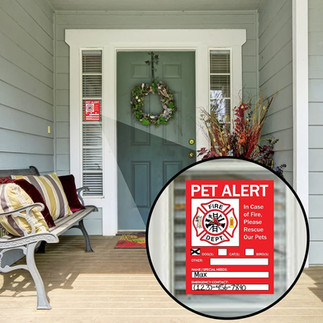
Photo by Gustavo Fring
Today is National Pet Fire Safety Day. When I lived alone, I enjoyed candles in the bathroom and around the house. They smelled so good and helped me to relax after a long day. When my husband and I moved into a trailer (temporarily until we built our house) out in the middle of the woods the candles came with us, but then we rescued our first two kittens as a couple, and we learned quickly how dangerous lit candles could be. We didn’t have to set anything on fire to see that the rambunctious and inquisitive kittens could do a lot of damage in a very short amount of time. The candles had to go.

Candles are just one example of a usually benign object becoming a hazard in a home with animals. Gas stoves can be another hazard if big dogs or cats are allowed to jump on counters in the kitchen or in the case of big dogs allowed to inspect while you are cooking. Even without you being home it is not unheard of for a dog to accidentally hit the knob on the stove and turn the gas on, or a cat to knock something flammable onto a hot stove. Pets are actually responsible for about 1,000 house fires in the United States every year, according to the American Humane Association.
All of these items can be found at Walmart, Amazon, and any home improvement store.
The hazards in the kitchen are not the only ones that need to be addressed. Puppies, kittens, and very board animals are often attracted to cords left exposed. Remember that Kittens and puppies go through teething the same way human babies do. And just like us, they have deciduous and permanent teeth. Teething puppies and kittens will chew on just about everything. They learn about the world by chewing through it. Animals with separation anxiety or who suffer from boredom will also find ways to soothe themselves or pass the time. They can be very destructive not only chewing on shoes and furniture, but also power cords. This behavior can lead to electrocution or serious shock to your fur kid and also lead to electrical fires.
While the percentage of pet-induced housefires is low relative to the number of households in the US with animals, there are still things you can do to reduce the chance that your house and your fur kids will be the next victims.
· Use flameless candles
· Do not allow animals in the kitchen or on counters
· Baby proof your home for kittens and puppies
· Use protective casing on power cords that must remain plugged in
· Make sure flammable items are stored away from range tops
· When able, use appliances with an automatic shut-off feature.
· Keep an up-to-date fire extinguisher in the kitchen and the garage
In the event of a fire have a plan. Have carriers ready for a quick getaway. If you are in the path of a fire. Grab your animals as fast as you can and get out if you have a house fire. Post a sign in the front of your house for Emergency Services to let them know you have animals that need to be saved if you are not home.
Our animals themselves often suffer the most consequences of housefires. The Red Cross sees about 500,000 pets suffer from smoke inhalation each year, while 40,000 will die due to home fires, says the American Veterinary Medical Association.
If you happen to live in a multi-story building this may be something you want to invest in.

More Resources:






תגובות